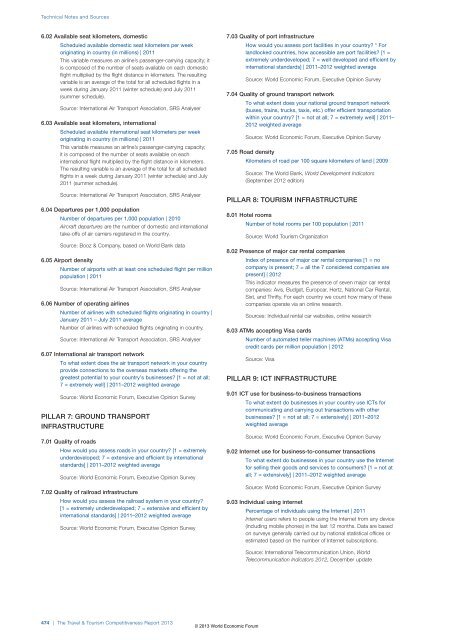The Travel & Tourism Competitiveness Report 2013
The Travel & Tourism Competitiveness Report 2013
The Travel & Tourism Competitiveness Report 2013
Create successful ePaper yourself
Turn your PDF publications into a flip-book with our unique Google optimized e-Paper software.
Technical Notes and Sources<br />
6.02 Available seat kilometers, domestic<br />
Scheduled available domestic seat kilometers per week<br />
originating in country (in millions) | 2011<br />
This variable measures an airline’s passenger-carrying capacity; it<br />
is composed of the number of seats available on each domestic<br />
flight multiplied by the flight distance in kilometers. <strong>The</strong> resulting<br />
variable is an average of the total for all scheduled flights in a<br />
week during January 2011 (winter schedule) and July 2011<br />
(summer schedule).<br />
Source: International Air Transport Association, SRS Analyser<br />
6.03 Available seat kilometers, international<br />
Scheduled available international seat kilometers per week<br />
originating in country (in millions) | 2011<br />
This variable measures an airline’s passenger-carrying capacity;<br />
it is composed of the number of seats available on each<br />
international flight multiplied by the flight distance in kilometers.<br />
<strong>The</strong> resulting variable is an average of the total for all scheduled<br />
flights in a week during January 2011 (winter schedule) and July<br />
2011 (summer schedule).<br />
Source: International Air Transport Association, SRS Analyser<br />
6.04 Departures per 1,000 population<br />
Number of departures per 1,000 population | 2010<br />
Aircraft departures are the number of domestic and international<br />
take-offs of air carriers registered in the country.<br />
Source: Booz & Company, based on World Bank data<br />
6.05 Airport density<br />
Number of airports with at least one scheduled flight per million<br />
population | 2011<br />
Source: International Air Transport Association, SRS Analyser<br />
6.06 Number of operating airlines<br />
Number of airlines with scheduled flights originating in country |<br />
January 2011 – July 2011 average<br />
Number of airlines with scheduled flights originating in country.<br />
Source: International Air Transport Association, SRS Analyser<br />
6.07 International air transport network<br />
To what extent does the air transport network in your country<br />
provide connections to the overseas markets offering the<br />
greatest potential to your country’s businesses? [1 = not at all;<br />
7 = extremely well] | 2011–2012 weighted average<br />
Source: World Economic Forum, Executive Opinion Survey<br />
PILLAR 7: GROUND TRANSPORT<br />
INFRASTRUCTURE<br />
7.01 Quality of roads<br />
How would you assess roads in your country? [1 = extremely<br />
underdeveloped; 7 = extensive and efficient by international<br />
standards] | 2011–2012 weighted average<br />
Source: World Economic Forum, Executive Opinion Survey<br />
7.02 Quality of railroad infrastructure<br />
How would you assess the railroad system in your country?<br />
[1 = extremely underdeveloped; 7 = extensive and efficient by<br />
international standards] | 2011–2012 weighted average<br />
Source: World Economic Forum, Executive Opinion Survey<br />
474 | <strong>The</strong> <strong>Travel</strong> & <strong>Tourism</strong> <strong>Competitiveness</strong> <strong>Report</strong> <strong>2013</strong><br />
7.03 Quality of port infrastructure<br />
How would you assess port facilities in your country? * For<br />
landlocked countries, how accessible are port facilities? [1 =<br />
extremely underdeveloped; 7 = well developed and efficient by<br />
international standards] | 2011–2012 weighted average<br />
Source: World Economic Forum, Executive Opinion Survey<br />
7.04 Quality of ground transport network<br />
To what extent does your national ground transport network<br />
(buses, trains, trucks, taxis, etc.) offer efficient transportation<br />
within your country? [1 = not at all; 7 = extremely well] | 2011–<br />
2012 weighted average<br />
Source: World Economic Forum, Executive Opinion Survey<br />
7.05 Road density<br />
Kilometers of road per 100 square kilometers of land | 2009<br />
Source: <strong>The</strong> World Bank, World Development Indicators<br />
(September 2012 edition)<br />
PILLAR 8: TOURISM INFRASTRUCTURE<br />
8.01 Hotel rooms<br />
Number of hotel rooms per 100 population | 2011<br />
Source: World <strong>Tourism</strong> Organization<br />
8.02 Presence of major car rental companies<br />
Index of presence of major car rental companies [1 = no<br />
company is present; 7 = all the 7 considered companies are<br />
present] | 2012<br />
This indicator measures the presence of seven major car rental<br />
companies: Avis, Budget, Europcar, Hertz, National Car Rental,<br />
Sixt, and Thrifty. For each country we count how many of these<br />
companies operate via an online research.<br />
Sources: Individual rental car websites, online research<br />
8.03 ATMs accepting Visa cards<br />
Number of automated teller machines (ATMs) accepting Visa<br />
credit cards per million population | 2012<br />
Source: Visa<br />
PILLAR 9: ICT INFRASTRUCTURE<br />
9.01 ICT use for business-to-business transactions<br />
To what extent do businesses in your country use ICTs for<br />
communicating and carrying out transactions with other<br />
businesses? [1 = not at all; 7 = extensively] | 2011–2012<br />
weighted average<br />
Source: World Economic Forum, Executive Opinion Survey<br />
9.02 Internet use for business-to-consumer transactions<br />
To what extent do businesses in your country use the Internet<br />
for selling their goods and services to consumers? [1 = not at<br />
all; 7 = extensively] | 2011–2012 weighted average<br />
Source: World Economic Forum, Executive Opinion Survey<br />
9.03 Individual using internet<br />
Percentage of individuals using the Internet | 2011<br />
Internet users refers to people using the Internet from any device<br />
(including mobile phones) in the last 12 months. Data are based<br />
on surveys generally carried out by national statistical offices or<br />
estimated based on the number of Internet subscriptions.<br />
© <strong>2013</strong> World Economic Forum<br />
Source: International Telecommunication Union, World<br />
Telecommunication Indicators 2012, December update

















